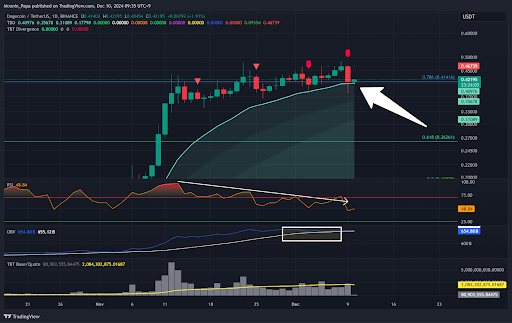(image courtesy of Coinglass.com)
Bitcoin and Market-Wide Liquidations
Bitcoin’s minor drop has shaken the market, triggering a cascade of liquidations totaling $1.4 billion across crypto assets. While Bitcoin’s price experienced minor volatility, Ethereum bore the brunt of the leveraged wipeout, with ETHUSDT on Binance leading the liquidation spree. This massive event highlights the market's fragility and the increasing role of manipulation in price movements.
While Bitcoin’s pullback was minor, it’s important to note how profoundly powerful the “Multiple Factor Effect” is in crypto, namely whenever Bitcoin has a pullback, we can expect ALTs to grossly overreact by a multiple of 1.2 times to 2.0 times (or more, in this recent pullback), proving that ALT coins are that much more volatile compared to Bitcoin.
Stablecoin Dominance: A Rebound or Temporary Spike?
Stablecoin dominance has spiked sharply, signaling heightened fear in the market. The chart reveals a double bottom formation, a classic pattern often associated with strong support and potential reversals. This uptick in stablecoin dominance aligns with the broader narrative of market participants retreating to safer assets during times of uncertainty. Despite this, key indicators like the TBO Slow line and On-Balance Volume (OBV) suggest that the overall trend for stablecoins remains bearish.
The return of stablecoin dominance into the TBO Cloud marks a transition to bullish consolidation, but its ability to sustain this level will determine the market's next move. The divergence between stablecoin dominance and crypto market sentiment is a crucial metric to monitor in the coming days.
Bitcoin Dominance and ALT Market Implications
Bitcoin dominance has surged alongside stablecoin dominance, a typical reaction during market-wide sell-offs. This movement reflects a retreat to perceived safer assets like BTC, even as altcoins suffer significant losses. However, the broader trend for Bitcoin dominance remains bearish, as evidenced by its position within the TBO Cloud and declining OBV on the weekly chart.
In contrast, the OTHERS dominance chart (representing altcoins) highlights the heavy toll of the recent dip, with a staggering 14% drop in market cap. This underscores the risk of chasing extended rallies, particularly when long-term resistance levels remain unbroken. While the TBO Slow line suggests a possible return to bullish momentum, traders should remain vigilant for follow-up dips before dominance shifts back to altcoins.
Strategies for Recovery and Navigating the Market
Amid the volatility, there are opportunities for disciplined traders. Focus on heavily oversold assets that are bouncing off key support levels, such as the TBO Fast line. These “TBO Springboard Bounces” often present excellent risk-reward setups. Conversely, charts that have fallen into the TBO Cloud indicate bearish consolidation and may require additional confirmation before entering trades.
Market corrections like this are rarely isolated events. Anticipate further dumps before a clear shift in dominance favors altcoins and low-cap assets again. By remaining patient and adhering to a well-structured trading plan, you can mitigate risk while capitalizing on recovery opportunities.
The Bigger Picture: Resilience in the Midst of Uncertainty
While the recent dip is a stark reminder of crypto’s volatility, it is also a testament to the market’s resilience. Historical patterns suggest that these pullbacks are part of a broader bull market cycle. For traders, the focus should remain on identifying oversold opportunities, monitoring dominance trends, and preparing for the eventual return of bullish momentum across the crypto market.

